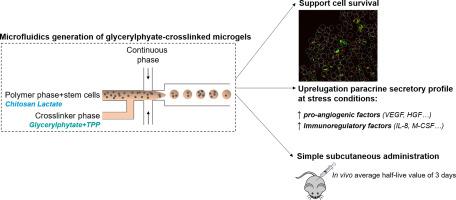Biomaterials Advances ( IF 5.5 ) Pub Date : 2020-11-10 , DOI: 10.1016/j.msec.2020.111716 Ana Mora-Boza 1 , Lina M Mancipe Castro 2 , Rebecca S Schneider 3 , Woojin M Han 2 , Andrés J García 2 , Blanca Vázquez-Lasa 1 , Julio San Román 1

|
Human mesenchymal stem cells (hMSCs) are an attractive source for cell therapies because of their multiple beneficial properties, i.e. via immunomodulation and secretory factors. Microfluidics is particularly attractive for cell encapsulation since it provides a rapid and reproducible methodology for microgel generation of controlled size and simultaneous cell encapsulation. Here, we report the fabrication of hMSC-laden microcarriers based on in situ ionotropic gelation of water-soluble chitosan in a microfluidic device using a combination of an antioxidant glycerylphytate (G1Phy) compound and tripolyphosphate (TPP) as ionic crosslinkers (G1Phy:TPP-microgels). These microgels showed homogeneous size distributions providing an average diameter of 104±12 μm, somewhat lower than that of control (127±16 μm, TPP-microgels). The presence of G1Phy in microgels maintained cell viability over time and upregulated paracrine factor secretion under adverse conditions compared to control TPP-microgels. Encapsulated hMSCs in G1Phy:TPP-microgels were delivered to the subcutaneous space of immunocompromised mice via injection, and the delivery process was as simple as the injection of unencapsulated cells. Immediately post-injection, equivalent signal intensities were observed between luciferase-expressing microgel-encapsulated and unencapsulated hMSCs, demonstrating no adverse effects of the microcarrier on initial cell survival. Cell persistence, inferred by bioluminescence signal, decreased exponentially over time showing relatively higher half-life values for G1Phy:TPP-microgels compared to TPP-microgels and unencapsulated cells. In overall, results position the microfluidics generated G1Phy:TPP-microgels as a promising microcarrier for supporting hMSC survival and reparative activities.
中文翻译:

微流体生成含有甘油植酸交联剂的壳聚糖微凝胶,用于原位封装人间充质干细胞
人间充质干细胞(hMSC)因其多种有益特性(即通过免疫调节和分泌因子)而成为细胞疗法的有吸引力的来源。微流体对于细胞封装特别有吸引力,因为它提供了一种快速且可重复的方法来生成受控尺寸的微凝胶并同时进行细胞封装。在这里,我们报告了在微流体装置中使用抗氧化剂植酸甘油酯(G 1 Phy)化合物和三聚磷酸盐(TPP)作为离子交联剂(G 1 Phy:TPP-微凝胶)。这些微凝胶表现出均匀的尺寸分布,平均直径为 104±12 μm,略低于对照(127±16 μm,TPP-微凝胶)。与对照 TPP 微凝胶相比,微凝胶中G 1 Phy的存在可以随着时间的推移维持细胞活力,并在不利条件下上调旁分泌因子的分泌。通过注射将封装在 G 1 Phy:TPP 微凝胶中的 hMSC 递送至免疫功能低下小鼠的皮下空间,递送过程与注射未封装的细胞一样简单。注射后立即在表达荧光素酶的微凝胶封装和未封装的 hMSC 之间观察到相同的信号强度,表明微载体对初始细胞存活没有不利影响。通过生物发光信号推断的细胞持久性随时间呈指数下降,显示与 TPP 微凝胶和未封装细胞相比,G 1 Phy:TPP 微凝胶的半衰期值相对较高。总体而言,结果表明微流体生成的 G 1 Phy:TPP 微凝胶是支持 hMSC 存活和修复活动的有前途的微载体。











































 京公网安备 11010802027423号
京公网安备 11010802027423号